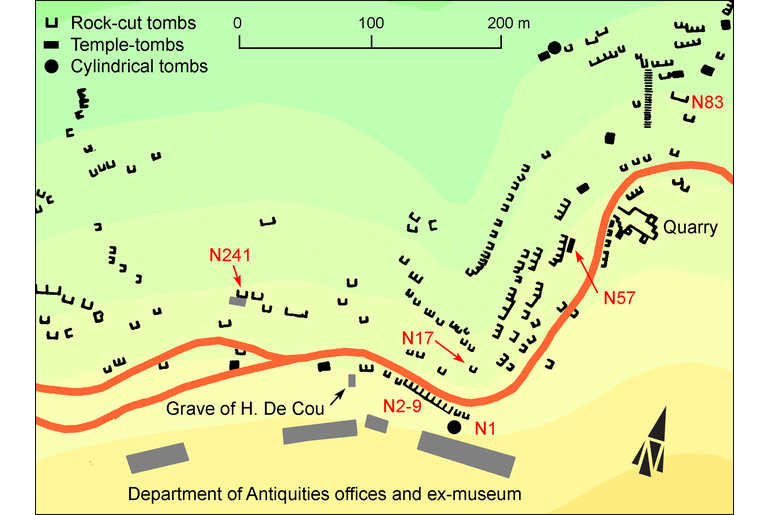Caption
IGCyr093200
Trismegistos ID: 738449
Source Description
Repository
Manchester Museum, M1185+M1333.
Support
Small local Derna limestone female half-figure with polos, clad in himation (0.15; 0.22;0.036).
Layout
Lightly scratched on the polos (height 0.018; diameter 0.06).
Letters
Height 0.006; width 0.024; lunate epsilon, alpha with dropped bar, probably cursive lettering.
Place of Origin
Findspot.
Date
Perhaps third century B.C.
Findspot
Found by A. Rowe in 1957 at Cyrene pleiades; HGL , North Necropolis : courtyard of N81 Cassels, sarcophagus KK Rowe.
Last recorded Location
Observed by S. Walker before 2005 in Manchester : Manchester Museum .
Present Location
Not seen by IGCyr team.
Text constituted from
Transcription from editor (CDL).
Bibliography
J.M. Reynolds in Reynolds-Thorn, 2005 Reynolds, J.M., Thorn, J.C., 2005, Cyrene’s Thea figure discovered in the Necropolis, Libyan Studies (LibStud)36, 89-100 - see in bibliography (dr.), whence SEG Supplementum Epigraphicum Graecum, Leiden, then Amsterdam, 1923-1971, then 1979- - see in bibliography , 55.1867. Cf. Rowe, 1959 Rowe, A., 1959, in A. Rowe, J.F. Healy (eds.), Cyrenaican Expeditions of the University of Manchester 1955, 1956, 1957; comprising an account of the excavated areas of the cemeteries at Cyrene and of objects found in 1952 by Alan Rowe, M.A. together with descriptions of the coins by John F. Healy, M.A., Ph.D., F.R.N.S., Manchester, 1-29 - see in bibliography , fig. 31b (discovery); Beschi, 1970 Beschi, L., 1970, Divinità funerarie cirenaiche, Annuario della Scuola Archeologica di Atene e delle Missioni Italiane in Oriente (ASAA)47-48, 133-341 - see in bibliography , pp. 133 ff., fig. 63.13.
Apparatus
1 Reynolds-Thorn, 2005 Reynolds, J.M., Thorn, J.C., 2005, Cyrene’s Thea figure discovered in the Necropolis, Libyan Studies (LibStud)36, 89-100 - see in bibliography Θεά : SEG Supplementum Epigraphicum Graecum, Leiden, then Amsterdam, 1923-1971, then 1979- - see in bibliography Θεᾷ (Tybout's suggestion)
French translation
Déesse.
English translation
Goddess.
Italian translation
Dea.
Arabic translation
الآلهه.
Commentary
Although the archaeological context seems to suggest a rather earlier date (fifth to fourth century) and although nothing is known about the development of the cursive lettering in Cyrenaica, we prefer to ascribe the graffito to a date somewhat later than the statue itself. When discussing this problem, J.M. Reynolds, who stressed the fact that this is a graffito, did not suggest that it might have been added later on. However, it was easy to add the letters on the limestone statue that was standing in the open air.
This is the first written mention of the funerary goddess, whoever she was, featured in the Cyrenaican half statues. For another mention of a nameless goddess, who is evidently Demeter, see at IGCyr114800.
We don't agree with Tybout, who at SEG Supplementum Epigraphicum Graecum, Leiden, then Amsterdam, 1923-1971, then 1979- - see in bibliography , 55.1867 thought that this was a dedication of «the deceased having been 'given' to the goddess». The nameless goddess was rather protecting the deceased.
Creative Commons Attributions-NonCommercial 4.0 International License.
All citation, reuse or distribution of this work must contain a link back to DOI: http://doi.org/10.6092/UNIBO/IGCYRGVCYR and the filename (IGCyr000000 or GVCyr000), as well as the year of consultation.
